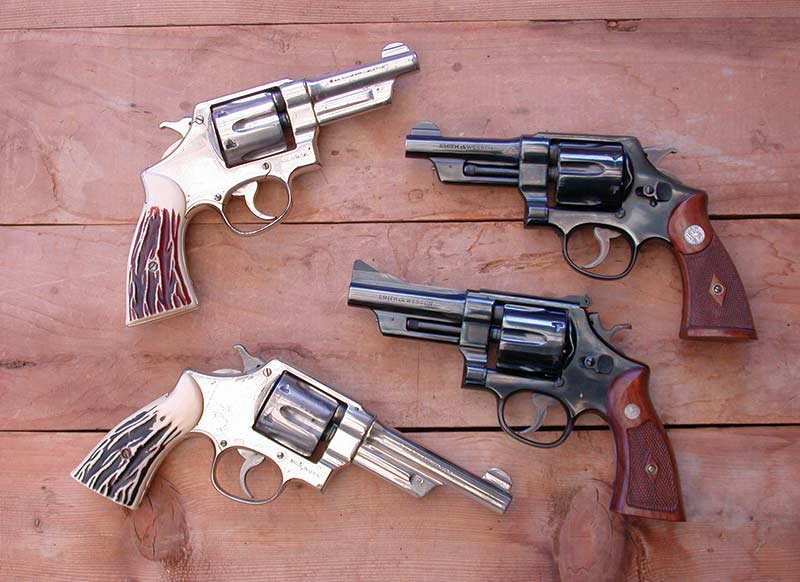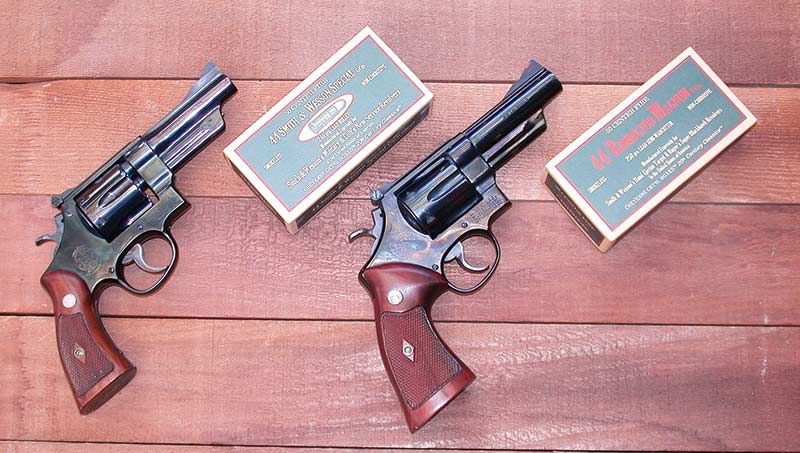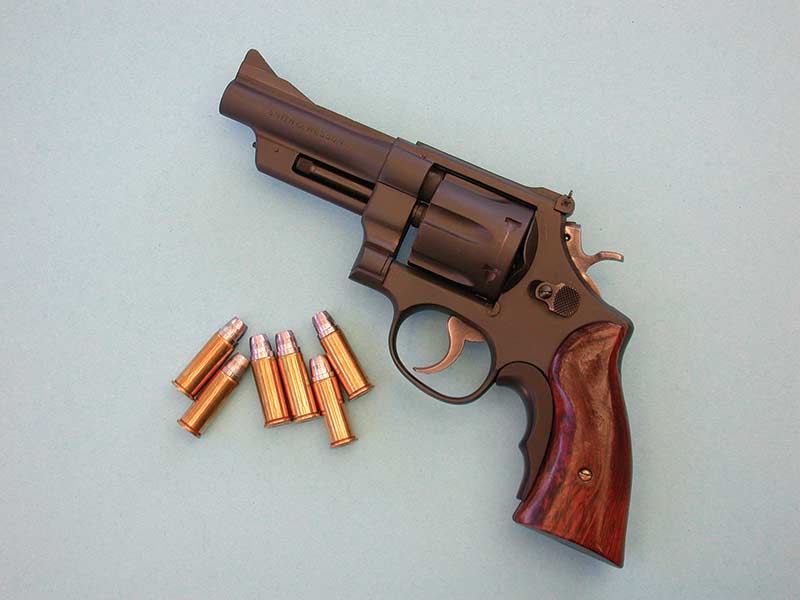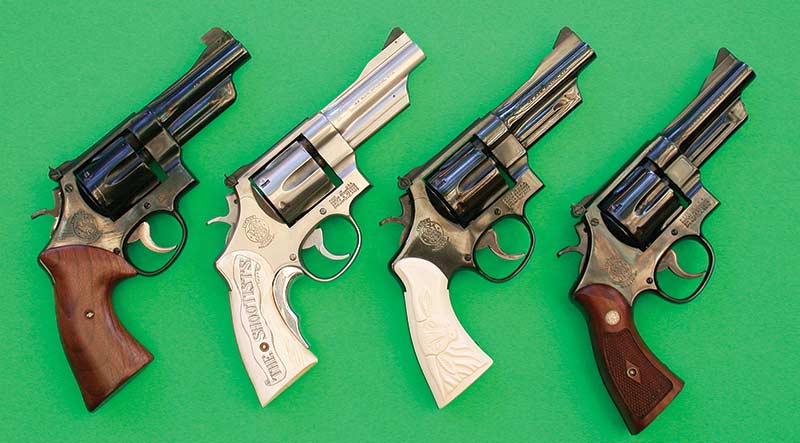The Searcher
An Epic Story Of One Man's Quest Across
The Western Landscape For The Perfect .44 Special
Growing up in the kinder, gentler 1950s was a wonderful experience for many reasons, not the least of which was the excellent, and very wise teachers I had in high school. Several of the men were returning veterans, while the English department was staffed with the proverbial old maid schoolteachers who not only knew their stuff but also had a great understanding of how to motivate kids.
The English department was backed up by another old maid, the librarian, who kept the shelves stocked with books that would be politically incorrect today — hunting books, exploring books, and the three top outdoor magazines of the time, Field & Stream, Sports Afield, and Outdoor Life.
About the same time, an aunt gave me a nearly worn out old typewriter, and this, coupled with my teachers and available resource materials, sent me on my way. Of course, I read everything assigned to me and reported on it, but I was also allowed to do extra credit work by typing reports on virtually every article found in those three magazines each month. My teachers encouraged a love of reading and writing, and I in turn taught them about Jack O’Connor, The Old Man and the Boy, and the Lower Forty Angling, Shooting, and Inside Straight Club.
The Man In The Big Hat
By the time I had become a junior in high school, another magazine arrived on the scene, this very same GUNS you are reading now. It wasn’t long before I discovered a new writer, Elmer Keith, and my life was changed forever. Sixguns became my passion. As if it wasn’t enough to be stirred by Keith’s articles and columns on a regular basis, I soon had a copy of his book, Sixguns by Keith.
I read it cover-to-cover and back again. I spent countless hours looking at the pictures of sixguns, especially the .44 Specials. The Colt Single Actions, of course, stirred my heart, soul, and spirit, but there were also double action Smith & Wessons, the Triple-Lock, the 1926 Model, and the 1950 Target, that had the same effect.
Pictured in the 1955 First Edition of Sixguns are Keith’s personal 4″ 1950 Target .44 Special, as well as son Ted’s 5″ 1950 .44 Special. Someday I would have one of each of these. Someday.
Marriage Changes Things
I soon met the girl of my dreams and for our first Christmas in 1959, my 19-year old wife presented me with my first .44 Special, a 6.5-inch barreled Model 1950 Target Model. The second edition of Sixguns arrived in 1961, and to the “Wish List” of these two magnificent .44 Specials was added the 4-inch S&W .44 Magnum, the sixgun Elmer Keith considered the perfect peace officer’s sidearm.
By now I was in college and also working full-time to support my fast-growing family, so the three .44 Special six-guns were pushed to my “Way Off In The Future Wish List.” In fact, it got even worse.
In 1962 I was faced with a terrible dilemma. I could feed my babies, now numbering two and a third on the way, or pay tuition, but not both. I was afraid if I dropped out of school I would never get back. We made the rounds of the gun shops with the purpose of (gulp!) selling guns. The 1950 Target, an early 2nd Generation .45 Colt SAA, and my Model ’94 Winchester all went. As we left the shop, my wife was in tears and sobbed, “You will never have to do that again.” Thankfully I never did, and, for the first time at that moment I knew she really understood.
Everybody Loved Skeeter
By the mid-1960s school was behind me. I had found a 4-inch .44 Magnum, however, both the 4- and 5-inch .44 Specials were virtually nonexistent as far as I was concerned. I had never seen either one so I tried to push them off the “Someday List” and onto the “Impossible To Find List.” I was doing okay. I could live without them. I could forget about them. And then, enter Skeeter Skelton.
Like Keith, Skeeter had a wonderful way of capturing readers and bringing them into the story. The problem for me was Skeeter’s favorite sixgun was an original 4-inch Model 1950 Target .44 Special. My heartache started all over again.
When the .44 Magnum arrived, Skeeter had sold his first 4-inch 1950 Target .44 Special and took up the short barreled .44 Magnum as his everyday packin’ pistol. He soon found for his use the recoil was excessive and the gun too heavy to carry comfortably all day, so he traded it off for another 4-inch barreled .44 Special. And therein is the beauty of the .44 Special.
It’s lighter by about one-half pound than comparable .44 Magnum sixguns, and with a handload consisting of a 250-grain Keith bullet over 7.5-grains of Unique, delivers an adequately powerful load of 900 to 950 fps. Skeeter espoused the 6.5-inch S&W .44 Magnum and 7.5-inch Ruger Blackhawk for hunting, but favored the short barreled .44 Special for nearly everything else requiring a big bore sixgun.
A Close Miss
I still could find neither an original 4- nor 5-inch S&W 1950 Target .44 Special. So once again, I decided it just wasn’t in the game plan for me. Then I came oh so close. I ran into a fellow who was getting ready to take a bunch of boys on a camping trip. It just so happened he was packing a sixgun for insurance. Not just any sixgun — it was an original 4″ S&W 1950 Target .44 Special. I was beside myself! I had finally seen one in person. Up close.
“Would you like to trade that .44 for something else?”
To him it was just a gun, so he was willing to talk trade when he got back from the trip. Well, in this case Murphy was an optimist. The very first morning he returned home, he started his truck and left it running in the driveway to warm up. When he came outside, the passenger side door was opened, the glove box was pilfered, and the S&W was long gone.
There was nothing left for me to do but take matters into my own hands. I now had another 6.5-inch 1950 Target that I had cut to 4 inches. A second .44 Special, a Model 1950 Military with fixed sights was fitted with a S&W adjustable rear sight assembly and a 6.5″ 1950 Target barrel trimmed to 5 inches. It wasn’t the same.
They were not original, but at least I had a 4″ and 5″ .44 Special. What I didn’t know at the time — none of us did — was how valuable both of these sixguns would be today if I had left them alone. Both had been purchased very reasonably at $80 new for the Target Model and $65 for the used Military Model in excellent shape. The latter now sells for around $1,200 if original. There’s a lesson there somewhere. The fact that these two sixguns were not original prevented my ardor from being completely cooled. The search continued.
Silk Purse Or Sow’s Ear?
I found a converted Model 28 Highway Patrolman at a gun show for $200. The previous owner had the cylinder re-chambered to .44 Special and fitted with a 4″ Model 24 barrel from a 1980’s run of .44 Specials by S&W. For some reason the project was never finished, and the satin blued Highway Patrolman turned .44 Special had a bright blue barrel. I was suspicious of this gun, especially due to the low price, but I did know the dealer. He admitted that the previous owner said it wouldn’t shoot.
Knowing full well it’s a rare gun that will not shoot, I agreed to buy it with the stipulation I could bring it back if it proved to be the exception. With my new .44 Special in hand I left the gun show and found a place to shoot. The previous owner was halfway correct. It would not shoot to point of aim. Apparently he did not understand that the two screws in the rear sight were for adjusting elevation and windage. Several turns here and several turns there and I had that little .44 Special hitting empty shotgun shells at 35 yards.
Now that I knew it would shoot, something had to be done about the finish. It was off to Hamilton Bowen to be bead blasted and re-blued. The result was a real, everyday working sixgun with a tough matte finish and service stocks that I would not sell for four times what I paid for it. Sometimes things just turn out right. Of course, I still had that nagging feeling that this was not an original 4″ 1950 Target.
The search continued to no avail. Original 1950 Target Model .44 Specials with the short barrel were simply not to be found. My wife tried to soothe my dejected feeling somewhat by presenting me with a pair of original and unfired 4″ .44 Special Model 24s as offered by S&W in 1983.
Yes they were original, yes they wore 4″ barrels, and yes they were deeply appreciated; however, they were not original 1950 Target Models. I liked them so well, however, I sent them off to Bob Leskovec to be ivory stocked Keith-style, with a carved longhorn steer — one on the left panel of one sixgun and the right panel of the other sixgun — to completely fill in the natural creases in the hands
.44 Special Family Tree
Back when it became painfully apparent I would not find a 4″ 1950 Target, I began to look for another 4″ S&W .44 Special. The 1950 Target Model was also known as the 4th Model Hand Ejector, and was produced from 1950 to 1957 when it became known as the Model 24. It was removed from production in 1966 with a total of 5,050 being manufactured. It then returned for a special run in 1983 with both 4- and 6.5″ versions offered for a total of 7,500 of the new big-bore sixguns. The predecessor of the 1950 Target Model was the 3rd Model Hand Ejector, or the 1926 Model. Since there was a 3rd Model and a 4th Model, one might reasonably expect both a 1st and 2nd Model.
The first .44 Special sixgun arrived late in 1907 with the Model of 1908, the .44 Hand Ejector First Model, the New Century, or as it is lovingly known among .44 Special devotees, the Triple-Lock. This beautifully crafted sixgun became the first of what would eventually be called N-frames, and Triple-Lock comes from the fact that the cylinder locked in three places — at the rear, at the front of the ejector rod, and with an exquisitely machined third lock at the front of the frame. This first S&W to feature an enclosed ejector rod housing originally sold for $21.
After producing slightly more than 15,000 New Centuries, S&W determined they were too expensive, and in 1915 dropped both the third locking feature and the enclosed ejector rod and brought forth the Second Model. This newer sixgun sold for only $19, so for the grand sum of $2 we lost what could easily be argued for as the finest double action sixgun ever made.
The big-bore .44 Special Triple-Lock was very popular with peace officers, especially those in the Southwest and along our southern border. The pre-World War II Smith & Wessons are usually referred to as having “long actions,” which are particularly good for shooting double action style. By the end of World War I, they were gone and a new group of peace officers and sixgunners came along to demand a return to the Triple-Lock, or at least an enclosed ejector rod housing.
S&W did not feel the demand warranted such a return until Wolf & Klar of Fort Worth, Texas, placed an order for 3,500 .44 Specials with enclosed ejector rod housings. Only 1,000 of the new 1926 Models were ever shipped to Wolf & Klar and from 1926 to 1940 as far as the S&W catalog was concerned, the Third Model did not exist and could only be special ordered. In spite of this, nearly 5,000 were made before the start of World War II.
For 45 years I had looked for an original 4-inch .44 Special S&W. I do not know which was worse, not being able to find 4″ Target Models, or finding unaffordable Model 1926 guns with four-figure price tags. It did not look like I would ever own an affordable Third Model Hand Ejector in excellent shape or even good shooting condition.
“Hey, Search That Guy”
Ten years ago, Roy Huntington, who is now editor of American Handgunner Magazine, was on the San Diego Police Department and arranged for the staff writers of GUNS and Handgunner to tour the department. What should I find in their gun room but a 1926 Model, 4″ .44 Special, nickel-plated and in excellent condition. Roy had me searched before leaving just in case I yielded to temptation.
Time passed. Years had become decades. Still no original 4-inch Target Model nor Model 1926 was to be had. Then just before Christmas 2000, I got a call from a reader who knew of my admiration for .44 Specials. He had been traveling in Oregon, spotted a like new .44 Special, and immedi-ately notified me. I was put in contact with Gunners Central Oregon Traders in Redmond, and talked with another gentlemen who also happened to be a reader of this magazine.
The Floodgates Open
He described a near-perfect, 4″ Model 1926 .44 Special, blue, fixed sights with Magna stocks, exactly what I have been seeking for four decades. The price was an extremely reasonable three figures, not four. Arrangements were made for shipping, and the normal inspection privilege that all honest gun dealers offer, and, when it arrived, I was pleasantly surprised to find it even better than described. Of course it had the wonderful old long action, and was exceptionally smooth. Once started, the double action almost seems to operate itself.
Somehow this first original 4″ .44 Special sixgun was the charm and soon lead to others. The fact that it was made the same year as I was a great omen and may have had something to do with this magical power. Nine months later I looked through my latest copy of the Old Town Station Dispatch and found a second 4-inch 1926 Model, this one nickel-plated, for a very attractive price.
Surely it would be gone, but I called anyway hoping against hope. They still had it! After four decades without an original 4″ .44 Special Hand Ejector, I now had two in less than one year. Other than needing re-crowned to remove a few minor dings at the muzzle, it was ready to go.
Nine months later, which now brings us to June 2002, one of the regulars at www.sixgunner.com posted a 1926 Model for sale, this time a 5″ nickel-plated .44 Special. The first five shots from that sixgun with .44 Special handloads cut one ragged hole at 50 feet. Good things really do come to those who wait, and the floodgates were seemingly opened. Would there be an original 4″ 1950 Target pouring through? Then it happened.

Get More Revolver Content Every Week!
Sign up for the Wheelgun Wednesday newsletter here:








